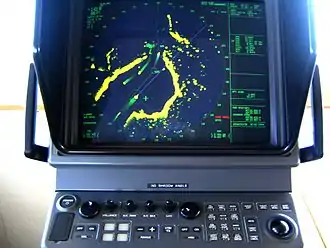Radar navigation
Radar navigation is the utilization of marine and aviation radar systems for vessel and aircraft navigation. When a craft is within radar range of land or special radar aids to navigation, the navigator can take distances and angular bearings to charted objects and use these to establish arcs of position and lines of position on a chart.[1] A fix consisting of only radar information is called a radar fix.[2]

Some types of radar fixes include the relatively self-explanatory methods of "range and bearing to a single object,"[3] "two or more bearings,"[3] "tangent bearings,"[3] and "two or more ranges."[3]
Parallel indexing is a technique defined by William Burger in the 1957 book The Radar Observer's Handbook.[4] This technique involves creating a line on the screen that is parallel to the ship's course, but offset to the left or right by some distance.[4] This parallel line allows the navigator to maintain a given distance away from hazards.[4]
Some techniques have been developed for special situations. One, known as the "contour method," involves marking a transparent plastic template on the radar screen and moving it to the chart to fix a position.[5]
Another special technique, known as the Franklin Continuous Radar Plot Technique, involves drawing the path a radar object should follow on the radar display if the ship stays on its planned course.[6] During the transit, the navigator can check that the ship is on track by checking that the pip lies on the drawn line.[6]
After completing the plotting radar technique, the image from the radar can either be displayed, captured or recorded to a computer monitor using a frame grabber.
See also
- Air navigation
- Celestial navigation
- Dead reckoning
- ECDIS
- Galileo positioning system
- Geodetic system
- Great-circle distance
- Marshall Islands stick chart
- Polynesian navigation
- Radio navigation
- Yeoman Plotter for transfer of data to paper chart
- Franz Xaver, Baron Von Zach, a scientific editor and astronomer, first located many places geographically.
Notes
- Maloney, 2003:744.
- Bowditch, 2002:816.
- National Imagery and Mapping Agency, 2001:163.
- National Imagery and Mapping Agency, 2001:169.
- National Imagery and Mapping Agency, 2001:164.
- National Imagery and Mapping Agency, 2001:182.
References
- Bowditch, Nathaniel (2002). The American Practical Navigator. Bethesda, MD: National Imagery and Mapping Agency. ISBN 0-939837-54-4. Archived from the original on 2007-06-24.
- Cutler, Thomas J. (December 2003). Dutton's Nautical Navigation (15th ed.). Annapolis, MD: Naval Institute Press. ISBN 978-1-55750-248-3.
- Department of the Air Force (March 2001). Air Navigation (PDF). Department of the Air Force. Archived from the original (PDF) on 2007-03-25. Retrieved 2007-04-17.
- Great Britain Ministry of Defence (Navy) (1995). Admiralty Manual of Seamanship. The Stationery Office. ISBN 0-11-772696-6.
- Maloney, Elbert S. (December 2003). Chapman Piloting and Seamanship (64th ed.). New York, NY: Hearst Communications Inc. ISBN 1-58816-089-0.
- National Imagery and Mapping Agency (2001). Publication 1310: Radar Navigation and Maneuvering Board Manual (7th ed.). Bethesda, MD: U.S. Government Printing Office. Archived from the original (PDF) on 2007-03-07.